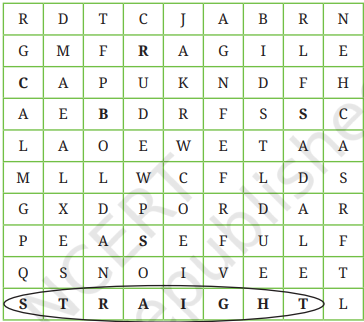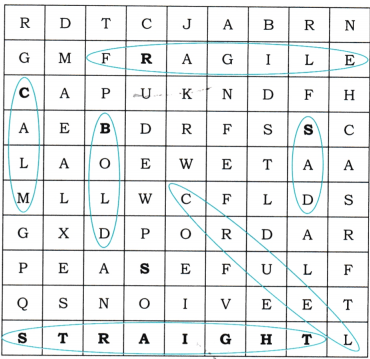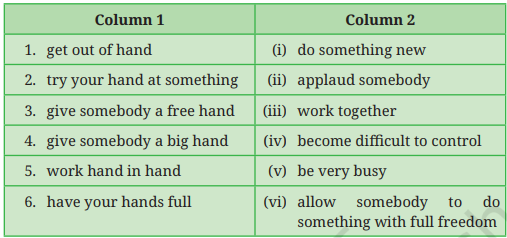Question Answer For All Chapters – English Poorvi Class 8th
Let us do these activities before we read.(Page 70)
I Recall a time you helped someone. Write two words describing:
1. What were your feelings after you did so?
Answer: My feelings after helping someone: Happy, Proud
2. What might have been the feelings of the person whom you helped?
Share your answers with your classmates and teacher.
Answer: Feelings of the person I helped: Grateful, Relieved
II Work in pairs. Read the words given below. Circle the words you would associate with an elderly person and underline the words you would associate with a school student. Share the reasons for your choices with your classmates and teacher.
Answer: Elderly person (circled): Worried, trembling, bent, grey, slow
School student (underlined): strong, hastening, firm, merry, guide, helpful
III Read the lines.
The woman was old and ragged and grey
And bent with the chill of the Winter’s day.
Select the suitable meaning of ‘ragged’ as used in these lines. There are other four meanings given below. Discuss with your classmates and teacher.
1. (of clothes) old and torn; synonym: shabby
• a ragged jacket
2. Having an outline, an edge, or a surface that is not straight or even
• a ragged coastline
3. Not smooth or regular; not showing control or careful preparation
• I could hear the sound of his ragged breathing.
• Their performance was still very ragged.
4. (Informal) very tired, especially after physical effort
• The elderly man was ragged after climbing the stairs.
Answer: 1. (of clothes) old and torn; synonym: shabby.
In the poem, the line describes the woman’s old, worn-out, and shabby clothes, showing her poverty and helplessness.
Let us discuss (Page 73)
I Arrange the events of the poem in the correct order of occurrence.
Share your answers with your classmates and teacher.
1. The boy returned to his friends, feeling proud of what he had done.
2. The old woman stood alone at the crossing, hesitant to move.
3. A group of schoolboys passed by, playing, and laughing.
4. The boy offered to help the old woman cross the street.
5. The woman prayed for the boy who helped her.
6. The children hurried past the old woman without offering help.
7. The woman placed her hand on the boy’s arm, and he guided her safely across the street.
8. The boy thought about his own mother and hoped someone would help her one day.
Answer:
2. The old woman stood alone at the crossing, hesitant to move.
3. A group of schoolboys passed by, playing, and laughing.
6. The children hurried past the old woman without offering help.
4. The boy offered to help the old woman cross the street.
7. The woman placed her hand on the boy’s arm, and he guided her safely across the street.
1. The boy returned to his friends, feeling proud of what he had done.
8. The boy thought about his own mother and hoped someone would help her one day.
5. The woman prayed for the boy who helped her.
II Fill in the blanks by choosing the correct answer from the options given in the brackets.
1. The central theme of the poem is _____________. (kindness and empathy/ adventure and courage)
2. The tone of the poem is _____________. (humorous and playful/ sympathetic and hopeful)
3. The poem is written in couplets with _____________ lines in each stanza. (four/two)
4. The structure of the poem gives a rhythmic flow that reflects both the _____________. (narrative and emotions/story’s pace and message)
5. The poem follows a rhyme scheme of _____________. (AABB/ABAB)
Answer:
1. kindness and empathy
2. sympathetic and hopeful
3. two
4. story’s pace and message
5. AABB
III Pick examples from the poem for the following poetic devices.
1. Simile
2. Alliteration
3. Repetition
Answer:
Simile:
- “Came the boys like a flock of sheep.”
Alliteration:
- “Glad in the freedom of school let out.” (repetition of ‘l’ sound)
- “Her aged hand on his strong young arm.” (repetition of ‘h’ sound)
Repetition:
- “Somebody’s mother” – repeated to emphasise respect and empathy for the old woman.
IV Complete the following sentences appropriately explaining the imagery.
1. The poem uses imagery to describe scenes of a bustling street.
We know this by the phrase _______________________.
2. The line ‘The street was wet with a recent snow’ suggests a cold and _______________________ weather, emphasising the woman’s helplessness.
Answer: 1. “amid the throng of human beings who passed her by.”
2.slippery
V Complete the following sentence with a suitable reason.
The poet repeats the phrase Somebody’s mother because it
_______________________.
VI Complete the analogy:
The old woman: vulnerable and neglected :: The young boy:
_______________________.
Answer: V. The poet repeats the phrase “Somebody’s mother” because it emphasizes the universal value of empathy and respect for all mothers, highlighting the connection between the boy’s kindness and the woman’s gratitude.
VI. The old woman: vulnerable and neglected :: The young boy: kind and helpful.
Let us think and reflect (Page 74-75)
I Read the given extracts and answer the questions that follow.
1. The woman was old and ragged and grey
And bent with the chill of the Winter’s day.
The street was wet with a recent snow
And the woman’s feet were aged and slow.
(i) What does the phrase ‘ragged and grey’ refer to ?
A. The woman’s emotional state that day.
B. The woman’s old and worn-out appearance.
C. The weather conditions of the particular day.
D. The colour of the street and the surroundings.
Answer: (i) B. The woman’s old and worn-out appearance.
(ii) Complete the following sentence with a suitable reason:
The woman was ‘bent’ with the chill of the Winter’s day because she was _______________________.
Answer: (ii) The woman was ‘bent’ with the chill of the Winter’s day because she was weak, shivering, and suffering from the cold due to her old age.
(iii) Identify the fact and opinion from the following sentences:
A. The street was wet with recent snow. _______________________
B. The woman was too weak to cross the street on her own.
_______________________.
Answer: A. The street was wet with recent snow. – Fact
B. The woman was too weak to cross the street on her own. – Opinion
(iv) Why do you think the woman’s feet were described as ‘aged and slow’?
Answer: (iv) The woman’s feet were described as ‘aged and slow’ to show her frailty, poor health, and difficulty in moving, emphasising her helplessness.
2. He guided the trembling feet along, Proud that his own were firm and strong. Then back again to his friends he went, His young heart happy and well content.
(i) What does the contrast between the ‘trembling feet’ of the old woman and the ‘firm and strong’ feet of the boy emphasise?
Answer: (i) The contrast between the ‘trembling feet’ of the old woman and the ‘firm and strong’ feet of the boy emphasises the difference between weakness and strength, old age and youth, and highlights the boy’s ability to help the frail woman.
(ii) Fill in the blank given below by selecting the correct option from the brackets.
• The poem tells us that the boy was ‘proud’ that his feet were strong.
• This tells us that the boy was ________. (arrogant about being strong/grateful for his ability to help)
Answer: (ii) This tells us that the boy was grateful for his ability to help.
(iii) What is the boy most likely to tell his friends on getting back?
A. I’m so glad I could help her.
B. I’m worried about her safety.
C. I’m surprised she forgot to thank me.
D. I’m thankful for all your support.
Answer: A. I’m so glad I could help her.
(iv) Rectify the false sentence given below.
The young boy’s actions were driven by a logical decision.
Answer: (iv) False sentence correction:
The young boy’s actions were driven by kindness and empathy, not just a logical decision.
II Answer the following questions.
1. What might be the old woman’s fears as she waited for a long time at the crossing?
Answer: The old woman might have feared slipping on the snowy road, being knocked down by carriages or horses, and not receiving help from the busy crowd around her.
2. How does the poet show the helplessness of the old woman? Support your answer with evidence from the poem.
Answer: The poet describes her as “old and ragged and grey” and “timid, afraid to stir,” showing that she was weak, poorly dressed, and scared. She stood alone, uncared for, while people passed her by, which highlights her helplessness.
3. Why does the boy decide to help the old woman? What does this tell us about him?
Answer: The boy helps her because he feels empathy and imagines his own mother in her place. This shows that he is thoughtful, kind-hearted, and compassionate.
4. How was the boy’s approach towards the old woman different from that of the other boys in the group?
Answer: While the other boys hurried past and ignored her, this boy paused, spoke gently, and helped her cross the street safely, showing his caring nature.
5. Justify the appropriateness of the title of the poem.
Answer: The title “Somebody’s Mother” is appropriate because it reminds readers that every elderly person is special to someone and deserves love, care, and respect.
6. What does the poem suggest about the role of empathy and humanity in society?
Answer: The poem teaches that empathy and humanity are essential for a compassionate society. Small acts of kindness, like the boy’s help, can bring hope and warmth to others’ lives.
Let us learn (Page 76,77)
I The grid given below has the antonyms of the words from the text. Locate these words in the grid horizontally, vertically, and diagonally. One example has been done for you. You may refer to a dictionary.
Answer:
II Match the words from the text given in Column 1 with the underlined phrases in Column 2.
Answer:
hastened → (iii) The students worked quickly to complete the project and submit it on time.
heeded → (vi) The stranded people were brought to safety because they paid attention to our advice.
stir → (i) The mother heard the baby move slightly in the cradle at night.
lend → (ii) It is our duty to give support to the poor.
piled → (iv) All the boxes were kept in a heap at one place.
offered → (v) They came forward to help us when we were in need.
III In the poem, the poet uses the idiom ‘lend a hand’ which means ‘help somebody’. Some more idioms using ‘hand’ are given in Column 1. Match these idioms with their meanings in Column 2. You may refer to a dictionary.
Answer:
1 – (iv)
2 – (i)
3 – (vi)
4 – (ii)
5 – (iii)
6 – (v)
IV Complete the following analogy by filling in the blanks with the correct words from the poem.
1. ___________ : winter :: heat : summer
2. hurt : ___________ :: old: aged
3. whispered : shouted :: humble : ___________
4. eyes : ___________ :: legs : walk
5. having a lot of money: wealthy :: densely packed people: ___________
Answer:
- 1. chill : winter :: heat : summer
- 2. hurt : harm :: old : aged
- 3. whispered : shouted :: humble : proud
- 4. eyes : see :: legs : walk
- 5. having a lot of money : wealthy :: densely packed people : throng
Let us listen (Page 78)
I You will listen to a woman read the special broadcast of the news. As you listen, arrange the pictures in the correct sequence of the events that took place. (Transcript for teacher on page 99)
Answer:
- 3. A woman stands near the riverbank.
- 6. She slips and falls into the water.
- 1. She struggles, trying to stay afloat.
- 5. A boy bravely dives into the river.
- 2. He pulls her safely out with others’ help.
- 4. The boy is later honoured on stage for his bravery.
II You will once again listen to the special broadcast of the news. As you
listen, complete the following sentences with one to three exact words.
1. The woman was having a difficult time staying afloat due to the _________________.
2. Rohan leapt into the river to save the woman without any _________________.
3. Rohan’s act of bravery was witnessed by _________________.
4. Rohan was honoured at the Vigyan Bhawan for his incredible courage and _________________.
5. Rohan proved that when it comes to saving lives, age is _________________.
Answer: 1. Strong Current.
2. hesitation.
3. Many people.
4. Selflessness.
5. No bar.
Let us speak (Page 79)
I Read aloud the list of words from the poem that end in ‘-ed’. As you read, focus on the final sound of each word and place them in the appropriate columns. One example has been done for you.
Note: Adjectives that come before a noun and end with ‘-ed’ have /id/as the final sound.
Answer:
| /id/ sound | /d/ sound | /t/ sound |
|---|---|---|
| ragged | heeded | paused |
| waited | aged | offered |
| guided | whispered |
II Work in pairs. Narrate an incident where you helped someone in the past. Take turns to speak and use the cue cards given below.
You may use the following prompts.
Answer: Do It Yourself.
Let us write (Page 80)
I Write a diary entry of a day you helped someone in need.
Remember to include the following points while writing it.
- Start with a sentence describing the day.
- Mention whom you helped.
- Explain the situation in which the other person needed help.
- Add the place and time of the day when the situation arose.
- Describe how you helped the other person.
- Describe the reaction of the person you helped.
- Mention how you felt during and after helping the person.
- Conclude by mentioning why you would do something like this again.
You may begin like this:
26 April 20xx, Saturday 8:00 p.m.
Dear Diary,
Today, I feel was a special day…
Answer:
26 April 20xx, Saturday, 8:00 p.m.
Dear Diary,
Today, I feel was a special day. In the afternoon, I helped an old man who was struggling to cross the busy road near the market. He looked nervous and weak, so I quickly held his hand and guided him safely across. He smiled warmly and blessed me. I felt very happy and proud. Helping him made me realise how small acts of kindness can mean a lot. I would surely do something like this again because it gives true joy.
– [Your Name]
IV Make a gratitude card for your mother/grandmother to thank her for at least five things that she does for you. Also write two things that you would do regularly to help them. Use recycled material to make and decorate the card.
Answer:
🌸 Gratitude Card 🌸
Dear Mother/Grandmother,
Thank you so much for everything you do for me. I am truly blessed to have you in my life.
✨ I am grateful to you for:
- Cooking delicious food every day.
- Taking care of me when I am sick.
- Teaching me good values.
- Helping me in my studies.
- Always loving and supporting me.
💖 I promise to:
- Help you with household chores regularly.
- Respect and care for you always.
With love,
Your Child ❤️













Leave a Reply